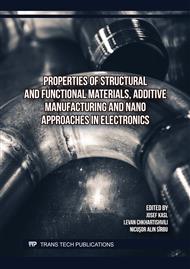[1]
A. Laureys, et al., Use of existing steel pipeline infrastructure for gaseous hydrogen storage and transport: A review of factors affecting hydrogen induced degradation. Journal of Natural Gas Science and Engineering. 101 (2022) 104534
DOI: 10.1016/j.jngse.2022.104534
Google Scholar
[2]
M. Wang, E. Akiyame, K. Tsuzaki, Effect of hydrogen and stress concentration on the notch tensile strength of AISI 4135 steel. Materials Science and Engineering A, 398 (2005) 37–46
DOI: 10.1016/j.msea.2005.03.008
Google Scholar
[3]
L. Cai, L.M. Zhao, Effect of Hydrogen Trapping and Poisons on Diffusion Behavior of Hydrogen in Low Carbon Steel, KEM. 764 (2018) 3-10
DOI: 10.4028/www.scientific.net/kem.764.3
Google Scholar
[4]
L.F. Lemus, et al., Hydrogen Trap on the Microstructure of Cr-Mo Type Steels, Defect and Diffusion Forum, 283–286 (2009) 370–375
DOI: 10.4028/www.scientific.net/ddf.283-286.370
Google Scholar
[5]
D. Haeseldonckx, W. D'haeseleer, The use of the natural-gas pipeline infrastructure for hydrogen transport in a changing market structure, Inter. J. of Hydrogen Energy. 32 (2007) 1381-1386
DOI: 10.1016/j.ijhydene.2006.10.018
Google Scholar
[6]
C. I. Garcia, et al., The alloy design and thermomechanically controlled processing (TMCP) of plate for high pressure, large diameter pipelines, Mater. Sci. Forum, 638-642 (2010) 124-129
DOI: 10.4028/www.scientific.net/msf.638-642.124
Google Scholar
[7]
R. G. Angus, Hydrogen Induced Damage in Pipeline Steels, Colorado School of Mines, Arthur Lakes Library. (2019)
Google Scholar
[8]
T. Zhang, W. Zhao, W. Guo, Y. Wang, Hydrogen Permeation Behavior through HSLA Steels and its Implications on Hydrogen Embrittlement Susceptibility, Applied Mechanics and Materials. 302 (2013) 310-316.
DOI: 10.4028/www.scientific.net/amm.302.310
Google Scholar
[9]
S. Dey, S. Sivaprasad, N. Das, S. Chattoraj, Study of Electrochemical Behavior, Hydrogen Permeation and Diffusion in Pipeline Steel, Mat. Sci. Forum. 1019 (2021) 145-156
DOI: 10.4028/www.scientific.net/msf.1019.145
Google Scholar
[10]
A. Juliawati, N. A. A. Razak, Hydrogen Embrittlement Susceptibility of Pipeline Steel, Applied Mechanics and Materials. 315 (2013) 820–824
DOI: 10.4028/www.scientific.net/amm.315.820
Google Scholar
[11]
X. Wu, et al., From the perspective of new technology of blending hydrogen into natural gas pipelines transmission: Mechanism, experimental study, and suggestions for further work of hydrogen embrittlement in high-strength pipeline steels. International Journal of Hydrogen Energy. 47 (2022) 8071–8090
DOI: 10.1016/j.ijhydene.2021.12.108
Google Scholar
[12]
E.J. Song, H. Bhadeshia, D. W. Suh, Effect of hydrogen on the surface energy of ferrite and austenite, Corrosion Sci., 77 (2013) 379-384
DOI: 10.1016/j.corsci.2013.07.043
Google Scholar
[13]
Q. Liu, et al., Determination of the hydrogen fugacity during electrolytic charging of steel. Corrosion Science. 87 (2014) 239–258
DOI: 10.1016/j.corsci.2014.06.033
Google Scholar
[14]
N. Ehrlin, C. Bjerkén, M. Fisk, Cathodic hydrogen charging of Inconel 718. AIMS Materials Science, 3(4) (2014) 1350-1364
DOI: 10.3934/matersci.2016.4.1350
Google Scholar
[15]
M. Gordiak, Methods of hydrogenation of steels for experimental purposes. VÚT Brno, Faculty of Mechanical Engineering, 2018. 35 p. Bachelor thesis.
Google Scholar


